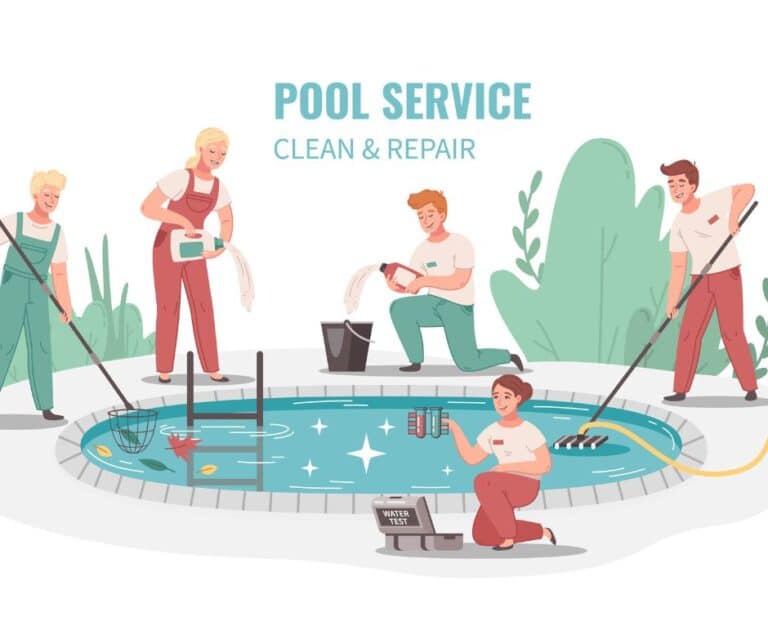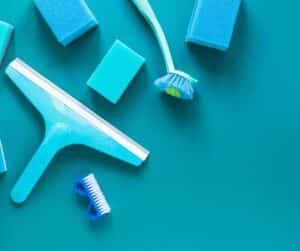How to Clean Your Swimming Pool in 7 Simple Steps

This guide helps pool owners maintain crystal-clear water with minimal effort. You’ll learn which essential cleaning tools you need, how to properly test water chemistry, and tips for setting up an easy maintenance routine that prevents algae and bacteria growth.
Gather Essential Pool Cleaning Tools
Essential skimmers and nets for debris removal
Look, pool cleaning isn’t rocket science, but you need the right tools. First up: skimmers and nets. These are your frontline defense against leaves, bugs, and all that other junk that loves to dive into your pool.
B. Brushes for different pool surfaces
Pool brushes aren’t one-size-fits-all, folks. Using the wrong brush is like washing your car with sandpaper – not a great idea.
For vinyl-lined pools, you need soft bristles. Anything too stiff will tear that liner faster than you can say “expensive repair bill.”
C. Vacuum equipment options for thorough cleaning
Manual vacuums are cheap but take time. They connect to your skimmer box and use your pool’s filtration system to suck up dirt. Effective but arm-straining work.
D. Chemical testing kits for water quality
Skip the guesswork with your pool chemistry. Testing kits are non-negotiable.
Strip tests are quick and easy – dip, compare colors, done. They’re good for basic readings but not super precise.
Liquid test kits take more time but give more accurate readings. You’ll add drops to a water sample and match the color to a chart. These are better for troubleshooting chemical imbalances.
Digital testers are pricey but crazy accurate. Just dip the probe in your water and get instant readings.
At minimum, you need to test for:
- Chlorine (free and total)
- pH
- Alkalinity
- Calcium hardness
Test weekly during swimming season, more often during heavy use or after rain. Bad chemistry equals algae, irritated skin, and cloudy water. Not exactly the pool party vibe you’re going for.
Test and Balance Pool Water Chemistry

How to use test strips correctly
Look, testing your pool water isn’t rocket science, but mess it up and you’re in for a world of algae trouble. Grab your test strips (they’re cheaper than digital testers and totally fine for most backyard pools).
Don’t just dip and glance! Submerge the strip about elbow-deep for 15 seconds—not 5, not 30. Pull it out, hold it level, and wait exactly as long as the package says before comparing colors. Those few extra seconds matter.
Ideal pH levels for swimming comfort
Your pool’s pH sweet spot? 7.4 to 7.6.
Why? Because that’s the same as your eyes’ natural tears. Drop below 7.2 and your skin gets itchy, your eyes burn, and metal parts start corroding. Climb above 7.8 and chlorine becomes lazy, plus you’ll get scaling on your pool surfaces.
Too many pool owners obsess over chlorine but ignore pH. Big mistake! You could dump buckets of chlorine in a high-pH pool and still grow enough algae for a science experiment.
Chlorine balancing for effective sanitization
Chlorine is your pool’s bouncer—it kicks out bacteria and other nasties trying to crash your swim party. Your free chlorine level should sit between 1-3 ppm.
When your chlorine dips below 1 ppm, algae sees that as an invitation to move in. Above 5 ppm, and you’re basically swimming in a mild bleach solution (hello, dry skin and bleached swimsuits).
Set Up a Regular Maintenance Schedule

. Daily quick-clean tasks that take minutes
Pool maintenance doesn’t have to eat up your day. Spend just 10 minutes on these quick tasks:
- Skim debris from the surface with a net
- Empty skimmer baskets
- Check water level and top up if needed
- Give pool walls a quick brush in problem areas
- Check pool chemistry with test strips
Do these little things daily, and you’ll save yourself from the nightmare of algae blooms and cloudy water later. Trust me, I’ve seen what happens when pools are neglected for “just a few days.”
- Weekly cleaning essentials
Once a week, block out about an hour for these must-dos:
- Vacuum the entire pool floor
- Brush all walls thoroughly
- Clean the waterline where oils and scum build up
- Backwash or clean the filter
- Test and adjust all water chemistry levels (pH, chlorine, alkalinity)
- Add maintenance chemicals as needed
Skip these weekly tasks and you’re basically inviting algae to throw a party in your pool.
- Monthly deep-cleaning requirements
Mark your calendar for these monthly jobs:
- Clean filter thoroughly (not just backwashing)
- Test cyanuric acid, calcium hardness, and metals
- Clean deck and surrounding areas
- Check equipment for leaks or unusual noises
- Shock treat the pool even if it looks clean
- Inspect ladders, rails, and diving boards for damage
- Seasonal maintenance considerations
Spring Opening:
- Remove and clean cover
- Clean and refill pool
- Inspect and start equipment
- Balance chemicals thoroughly
- Shock treat heavily
Summer Maintenance:
- Increase testing frequency during heavy use
- Add chlorine more often during hot periods
- Clean filters more frequently
Winter Closing:
- Add winterizing chemicals
- Cover securely
- Protect equipment from freezing
Stick to this schedule and your pool will always be swim-ready without those panic cleanings when guests announce they’re coming over.
By following these seven simple steps—gathering the right tools, balancing water chemistry, removing debris, brushing surfaces, vacuuming thoroughly, maintaining your filtration system, and establishing a regular cleaning schedule—you can enjoy crystal-clear water all season long.
Remember that consistency is key to pool maintenance. A little attention every week prevents bigger problems and more intensive cleaning later. Your reward for this regular care? A sparkling clean pool that’s always ready for you, your family, and friends to enjoy safely. Happy swimming
